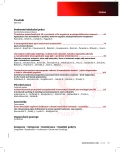Life-threatening organ infiltration in acute myeloid leukemia: case-reports
Authors:
T. Karvunidis 1; 2; J. Raděj 1,2; D. Lysák 2,3; M. Matějovič 1,2
Authors‘ workplace:
I. interní klinika, Lékařská fakulta v Plzni, Univerzita Karlova a Fakultní nemocnice Plzeň
1; Biomedicínské centrum, Lékařská fakulta v Plzni, Univerzita Karlova
2; Hematologicko-onkologické oddělení, Fakultní nemocnice Plzeň
3
Published in:
Transfuze Hematol. dnes,24, 2018, No. 2, p. 123-127.
Category:
Case Reports
Overview
The set of case-reports describes two cases of critically-ill patients with newly diagnosed acute myeloid leukemia. It discusses briefly the significance of extramedullary leukemic organ infiltration according to their dysfunction, disease course and management. Moreover, it notices the rapid deterioration of clinical condition, being relatively typical for such patients, and therefore the need of early therapeutic intervention.
Key words:
acute myeloid leukaemia – leukemic infiltration – intensive care – organ failure
Sources
1. Ganzel C, Manola J, Douer D, et al. Extramedullary disease in adult acute myeloid leukemia is common but lacks independent significance: analysis of patients in ECOG-ACRIN cancer research group trials, 1980–2008. J Clin Oncol 2016;34(29):3544–3553.
2. Byrd JC, Mrózek K, Dodge RK, et al. and Cancer and Leukemia Group B (CALGB 8461). Pretreatment cytogenetic abnormalities are predictive of induction success, cumulative incidence of relapse, and overall survival in adult patients with de novo acute myeloid leukemia: results from Cancer and Leukemia Group B (CALGB 8461). Blood 2002;100(13):4325–4336.
3. Marsh WL, Bylund DJ, Heath VC, Anderson MJ. Osteoarticular and pulmonary manifestation of acute leukemia. Case report and review of the literature. Cancer 1986;57(2):385–390.
4. Evans TI, Nercessian BM, Sanders KM. Leukaemic arthritis. Semin Artritis Rheum 1994;24(1):48–56.
5. Makaryus AN, Tung F, Liu W, et al. Extensive neoplastic cardiac infiltration in a patient with acute myelogenous leukemia: role of echocardiography. Echocardiography 2003;20(6):539–544.
6. Sharma T, Grewal J, Gupta S, Murray PI. Ophthalmic manifestation of acute leukaemias: the ophthalmologists´ role. Eye (Lond) 2004;18(7):663–672.
7. Bakst RL, Tallman MS, Douer D, Yahalom J. How I treat extramedullary acute myeloid leukemia. Blood 2011;118(14):3785–3793.
8. Alakel N, Stoelzel F, Mohr B, et al. Symptomatic central nervous system involvement in adult patients with acute myeloid leukemia. Cancer Manag Res 2017;9:97–102.
9. Roberts WC, Bodey GP, Wertlake PT. The heart in acute leukemia. A study of 420 autopsy cases. Am J Cardiol 1968;21(3):388–412.
10. ung MH, Lee YH, Lee KY, et al. Leukemic infiltration presenting as myocardial hypertrophy after complete remission of acute myeloid leukemia. Echocardiography 2017;34(1):136–138.
11. da Silva GL, Valle S, Pinto FJ, Almeida AG. Leukaemic myocardial infiltration presenting as acute heart failure. Eur Heart J Cardiovasc Imaging 2015;16(4):460.
12. Sampat K, Rossi A, Garcia-Gutierrez V, et al. Characteristics of pericardial effusions in patients with leukemia. Cancer 2002;116(10):2366–2371.
13. Darmon M, Thiery G, Ciroldi M, et al. Intensive care in patients with newly diagnosed malignancies and a need for cancer chemotherapy. Crit Care Med 2005;33(11):2488–2493.
14. Benoit DD, Depuydt PO, Vandewoude KH, et al. Outcome in severely ill patients with hematological malignancies who received intravenous chemotherapy in the intensive care unit. Intensive Care Med 2006;32(1):93–99.
15. Vandijck DM, Benoit DD, Depuydt PO, et al. Impact of recent intravenous chemotherapy on outcome in severe sepsis and septic shock patients with hematological malignancies. Intensive Care Med 2008;34(5):847–855.
16. Karvunidis T, Lysák D, Matějovič M. Dospělý onkologický nemocný v intenzivní péči. Je již čas říci „ano, zvážíme to“, než říkat „ne“,?! Anest Intenziv Med 2017;28:346–353.
17. Tanvetyanon T, Leighton JC. Life-sustaining treatments in patients who died of chronic congestive heart failure compared to metastatic cancer. Crit Care Med 2003;31:60–64.
18. Benoit DD, Vandewoude KH, Decruyenaere JM, et al. Outcome and early prognostic indicators in patients with a hematologic malignancy admitted to the intensive care unit for life-threatening complication. Crit Care Med 2003;31:104–112
Labels
Haematology Internal medicine Clinical oncologyArticle was published in
Transfusion and Haematology Today

2018 Issue 2
- Neutralizing Antibodies Against Emicizumab – Detailed Analysis Based on a Case Study
- Position of aPCC in the Treatment of Hemophilia A Complicated by the Development of Inhibitors
- Sport and Physical Activity Benefit Hemophiliacs
- What FVIII Levels Are Ideal for Preventing Bleeding in Hemophilia A?
- Administration of aPCC as a Prevention of Bleeding After Major Cardiac Surgical Procedures
Most read in this issue
- IgG4 releated disease
- Chronic recurrent urticaria, joint and bone pain, fever of unknown origin and monoclonal IgM = Schnitzler’s syndrome
- Hereditary erythroenzymopathies associated with haemolytic anaemia – their diagnostics in the czech and Slovak populations
- Splanchnic vein thrombosis in patients with Ph-negative myeloproliferative neoplasms
